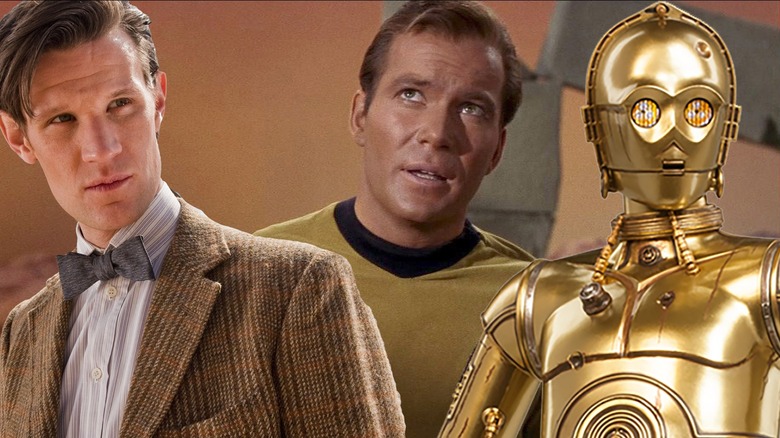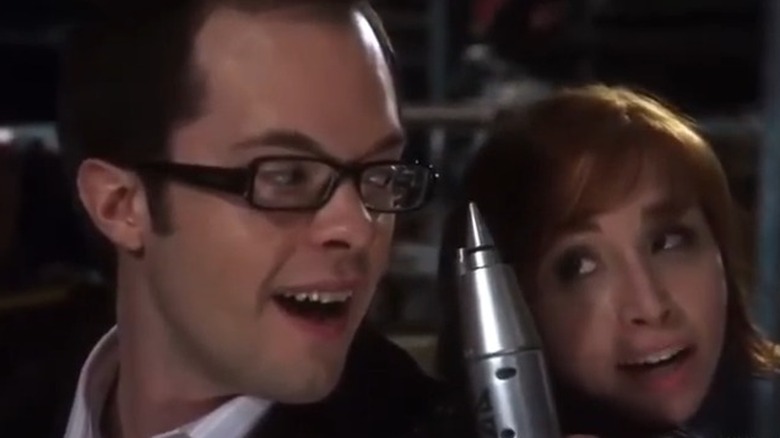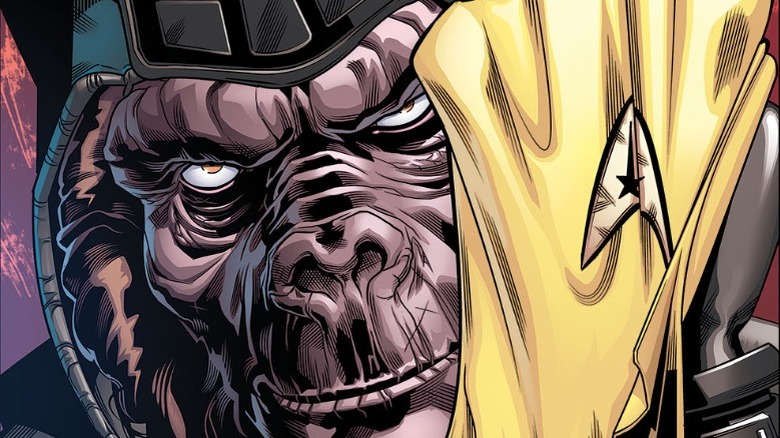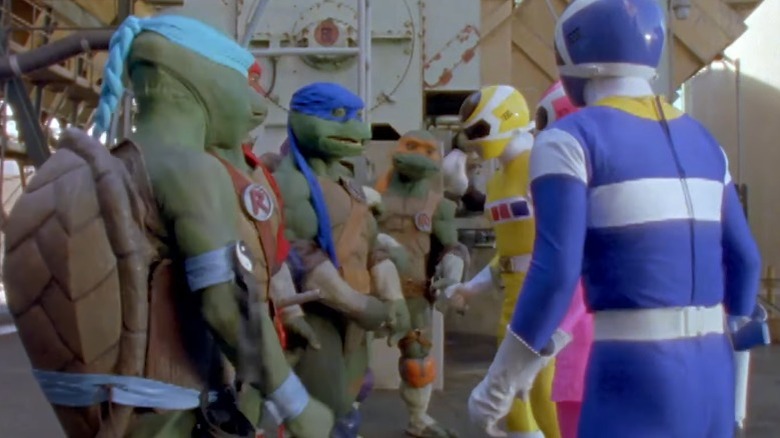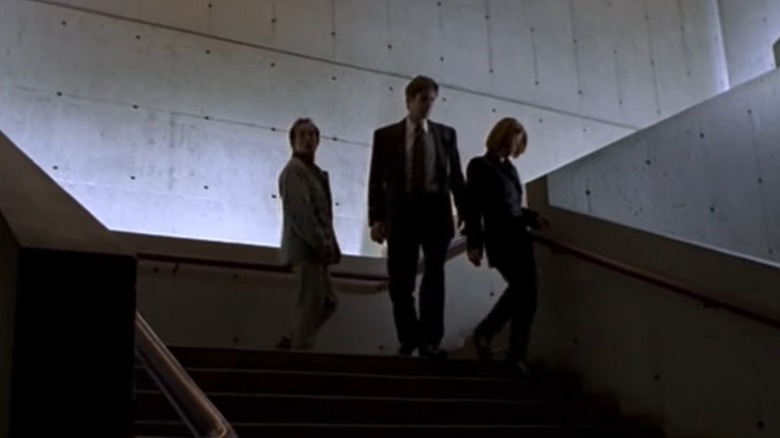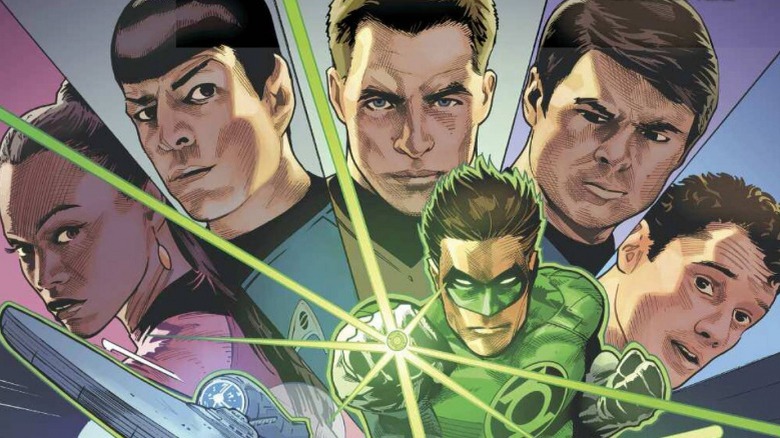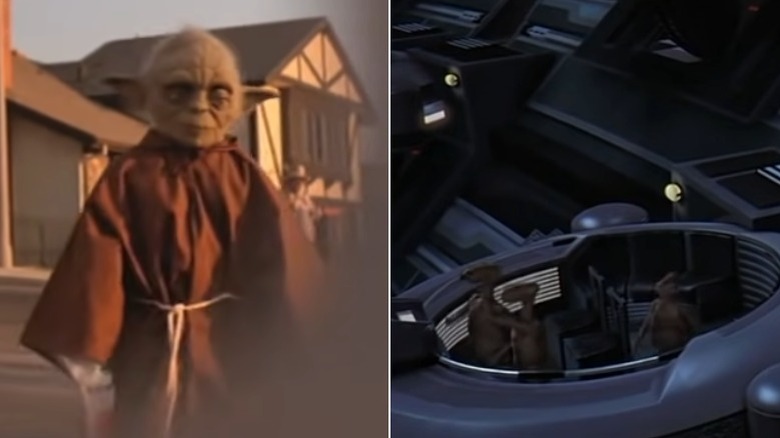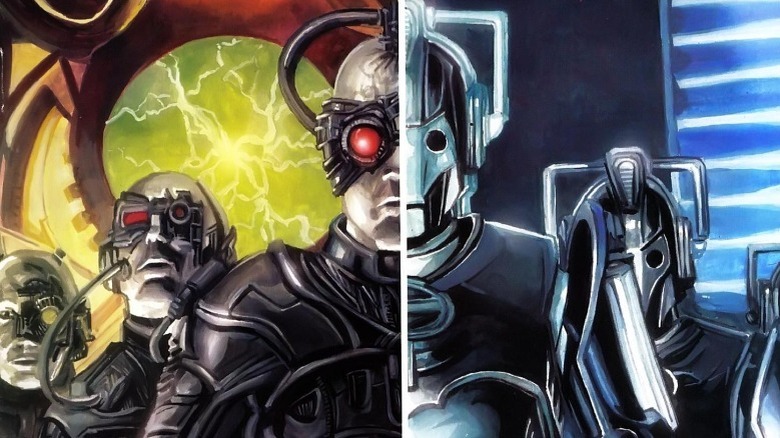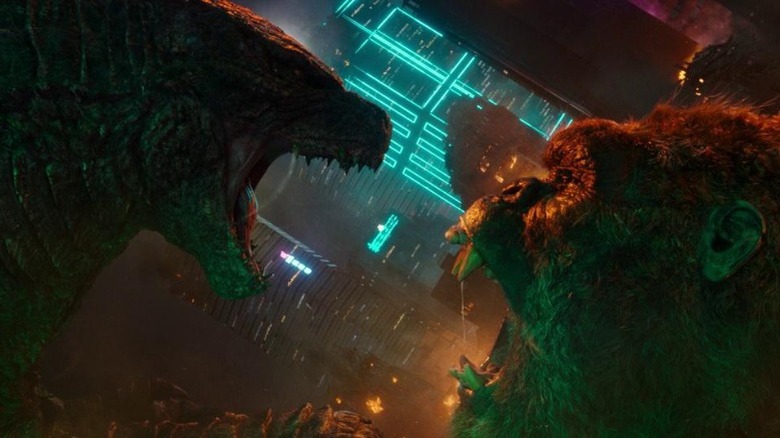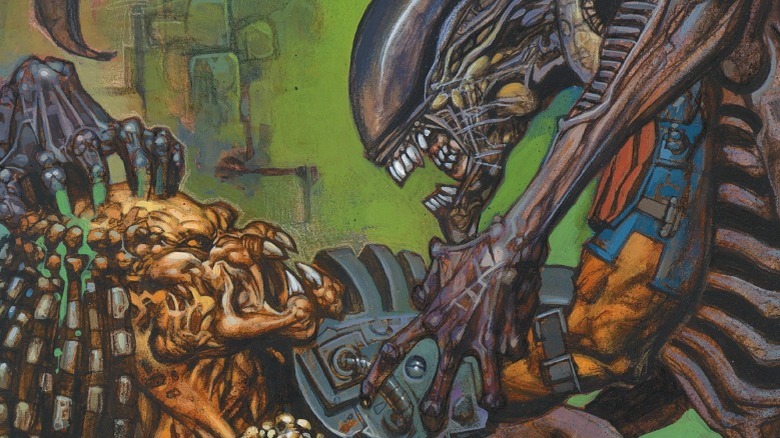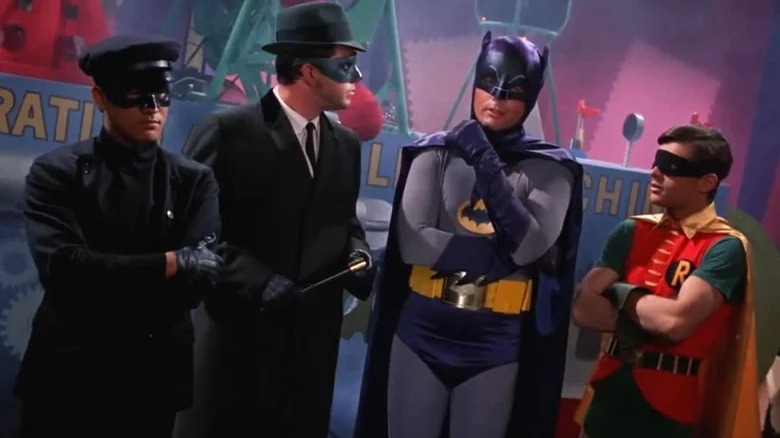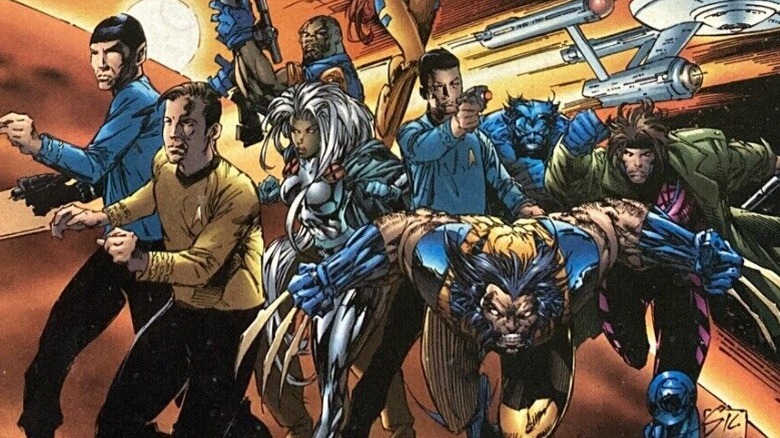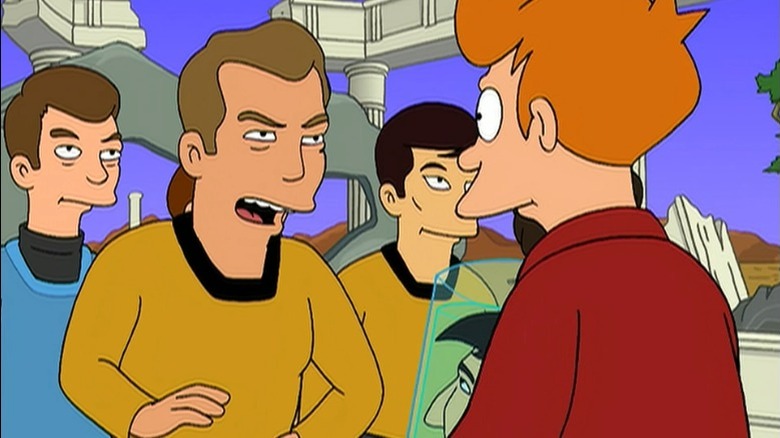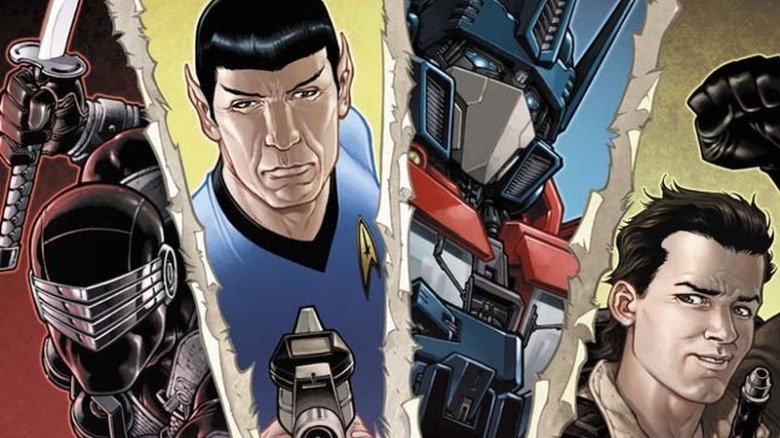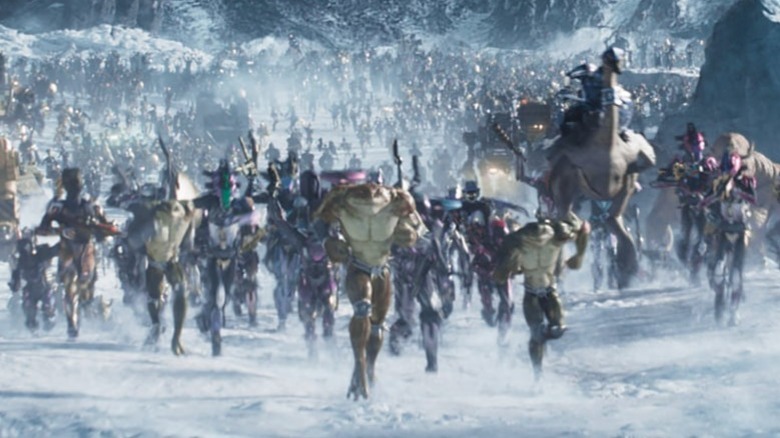The Best Sci-Fi Crossovers That May Have Slipped Under Your Radar
We may receive a commission on purchases made from links.
Science fiction is a genre with a multitude of subgenres, giving it perhaps the most extensive reach of any in popular culture. Some of the most beloved films, comics, and television series are firmly set within the realm of sci-fi, many with a massive following of fans. Franchises like "Star Wars," "Star Trek," and others often have followers numbering in the tens of millions... if not more.
Because sci-fi is such a popular genre, companies have been merging them for some time, creating unique crossover events in all forms of media. Every once in a while, you'll see the crew of the USS Enterprise teaming up with the Doctor in his TARDIS or the X-Men in the pages of Marvel Comics. Whatever the medium, there are examples of science fiction franchises fraternizing, and fans lined up to fantasize over the possibilities.
Often, these kinds of crossovers are equal parts fan service and outrageous storylines, so they don't always make a ton of sense. But that rarely matters when fans get more of what they love, and that's pretty much what a good sci-fi crossover is — a combination of IPs in a fun, exciting new setting. Below, arguably the best to ever see the light of day.
Warehouse 13/Eureka
The mid to late aughts was a successful time for the Sci-Fi Channel (renamed "SyFy" in 2009), thanks to two series that proved to be quite popular. The first was "Eureka," a series set in the eponymous town peopled entirely by über geniuses. Eureka was the home of Einstein and Oppenheimer's descendants, and every week, some new form of crazy technology went haywire and required the sheriff's assistance to quell. A few years after "Eureka" debuted, "Warehouse 13" followed, with a premise that was somewhat similar.
"Warehouse 13" is where all the world's dangerous artifacts are stored, and it's up to two Secret Service agents to track them down. The eponymous warehouse was likened to "America's Attic," and it stored everything imaginable within, including H.G. Wells' time machine, Lewis Carroll's looking glass, and much more. It was only a matter of time before the two worlds collided, and they did so through a crossover episode from each series.
The "Warehouse 13" episode, entitled "13.1" features "Eureka" star Douglas Fargo showing up at the warehouse to help Claudia install and update a new security system, and things go horribly wrong. In "Eureka" crossover "Crossing Over," Claudia visits Eureka hoping to see some cool new tech. Unfortunately, when random objects start popping up all over town, she and Fargo must work with Sheriff Carter to solve the problem. Both episodes established a potential, yet un-pursued romantic relationship between Claudia and Fargo, which helped tie both series together quite nicely.
Star Trek/Planet of the Apes
"Star Trek" is one of the most beloved science fiction franchises ever created, so having it crossover with another high-profile franchise makes sense. That said, one that most fans likely never expected to see "The Original Series" cast of characters exist alongside is probably "Planet of the Apes." Like "Trek," "Planet of the Apes" is an expansive franchise spanning nearly a dozen films, a television series, books, and comics — which is where this particular crossover takes place, thanks to IDW Comics and Boom! Studios.
The 2014 series "Star Trek/Planet of the Apes: The Prime Directive" is a crossover collaboration published by Boom1 and IDW. The limited series covers five issues that feature the debut artwork of talented illustrator Rachael Stott. The crossover takes characters from each franchise and throws them together via a portal between universes. A Klingon vessel and the USS Enterprise travel through the portal to arrive in the "Planet of the Apes" universe.
Once there, Captain James T. Kirk and company work to stop the Klingons from enacting their plan to install a puppet gorilla government on Earth. The only thing standing in their way is the Prime Directive. Still, with the aid of the chimpanzees and George Taylor, they stop the Klingon plan. Cornelius, Milo, and Zira are left in orbit with a tricorder and a plan to transport them back in time using the same trick the Enterprise crew pulled off in "Star Trek IV: The Voyage Home."
Power Rangers in Space/The Teenage Mutant Ninja Turtles
"Power Rangers in Space" is the sixth season of the popular series from Saban, and it closed out the Zordon Era. The fourth episode of the season, "Shell Shocked," saw the Space Rangers team up with an unlikely ally in the Teenage Mutant Ninja Turtles. While this was a live-action depiction of the Turtles, it wasn't a crossover with the feature films that were popular at the time. Instead, the crossover is from the television series "Ninja Turtles: The Next Mutation."
In the episode, Astronema brainwashes the Teenage Mutant Ninja Turtles, and while they're under her spell, they approach the Space Rangers. Their mission is to get the Rangers to let them on the Astro Megaship so Astronema can take it from them. The Turtles meet the Rangers, and Astronema is successful ... briefly. The Rangers are able to escape, and an electric storm undoes her brainwashing. As you can imagine, the Turtles weren't happy being used.
The Rangers return and lend a hand, and the Turtles team up with them and boot Astronema from the ship. Everything is sorted by the end, and the Turtles return to New York after a quick Galaxy Glide in space. Because the costumes were from "The Next Mutation," which wasn't one of the best adaptations in the TMNT franchise, the episode includes Venus De Milo, a female Turtle introduced in the series. Still, doing this put five Turtles on screen opposite five Rangers, so it works.
The X-Files/Millennium
"The X-Files" was a steady performer on Fox throughout the 1990s, and it crossed over with several other series, including "The Simpsons," "Cops," and more. The show also featured a crossover with "Millennium," a somewhat similar series canceled too soon, having run from 1996 to '99. When the show ended, it came suddenly, leaving some open stories that left fans wanting more. The "X-Files" stepped in to save the day or, at the very least, offer some closure.
In "The X-Files" seventh season, the episode "Millennium" served two purposes. It featured a crossover with the series "Millennium," and it closed the story for Frank Black, the series' protagonist played by Lance Henriksen. In "Millennium," Black worked as a freelance forensic profiler who was once an FBI Agent. He has the unique ability to see through the eyes of murderers and serial killers, which comes in handy when investigating that sort of thing.
"Millennium" features Agents Mulder and Scully investigating a previously-occupied grave. They turn their investigation to the now-dissolved Millennium Group, taking them to Frank Black, who is undergoing treatment at a mental institution. He's reluctant to help but comes around and gives them assistance. There are zombies, an end-of-the-world millennium threat, and many near-death experiences. In the end, Black decides to check himself out of the mental institution and the clocks strike midnight, ringing in the new year with the apocalypse notably absent.
Star Trek/Green Lantern
"Star Trek" is all about exploring space, and the Green Lantern is all about policing it. They come from different universes, but that doesn't mean they can't crossover every now and again. The first such crossover came in 2015, via a collaboration between DC Comics and IDW Publishing. The series, "Star Trek/Green Lantern: The Spectrum War," was followed by "Star Trek/Green Lantern: Stranger Worlds" the following year. In both series, the crew from the USS Enterprise in the Kelvin Timeline find themselves involved with some of the most powerful cosmic characters of the DC Universe.
In "Spectrum War," Ganthet uses his godlike abilities to send himself and the remaining power rings to another universe to escape Nekron, and you can guess where they land. The Enterprise crew discovers Ganthet's remains and accidentally activates the rings as they come under attack by the Klingons. Chekov, Uhura, and McCoy receive rings, while the yellow, orange, and red rings find homes with several bad guys. Hal Jordan eventually intervenes, as does Star Sapphire and other favorites from the comics.
Nekron finds his way to the Kelvin Universe, and chaos ensues, but he's ultimately defeated. In 'Stranger Worlds," the Enterprise seeks out the planet Oa in the Kelvin Universe, as Khan gets his hands on a red power ring. Sinestro manages to free the yellow light being trapped in the Green Power Battery, and it all comes to a head in a massive battle between pretty much everyone involved.
E.T.: The Extra-Terrestrial/Star Wars
Steven Spielberg and George Lucas have been friends for decades, and they've worked together on multiple (typically, hugely successful) projects. Their collaborations have led to more than a few crossovers and friendly homages to one another, which is why you can find R2-D2 and C-3PO in some hieroglyphics during a scene in "Raiders of the Lost Ark." Of course, the directors don't limit their crossovers to movies they work on together, so you can find two prominent ones in "E.T.: The Extra-Terrestrial" and "Star Wars: Episode I — The Phantom Menace."
In "E.T.," during the Halloween scene with the children dressing up their alien friend as a ghost (and pretending he's Gertie), there are several characters wearing costumes. As E.T. peers through the holes in his costume/sheet, he notices some notable characters, lingering on one in particular. A child approaches dressed as Jedi Grand Master Yoda, and the camera stays on this kid long enough for any fan to register that this movie is set in a world where "Star Wars" exists.
Decades later, Lucas took things a step further with "The Phantom Menace." Numerous alien species can be seen participating in the background during the scenes involving the Galactic Senate, and some are close-up, while others are a bit further away. When Queen Padmé Amidala calls for a no-confidence vote on the chancellor, numerous senators cheer or express their outrage. One group of representatives is made up of the same species as E.T., which the Wookiepedia calls "Asogians."
Star Trek: The Next Generation/Doctor Who
If studying the best sci-fi franchises for cyborgs, you'll find the likes of the Terminator and Robocop. If you branch out further, you'll stumble upon two groups from separate franchises that are decidedly similar. The Borg from "Star Trek" and the Cybermen from "Doctor Who" are very much alike. Each race is comprised of individuals forced into their society. They both believe themselves to be superior, and they're terrifying. With all that, you can't blame the folks at IDW for putting them together into one comic miniseries.
"Star Trek: The Next Generation/Doctor Who: Assimilation²" is an eight-part miniseries that places the crew of the Enterprise-D from "Star Trek: The Next Generation" with the Doctor, his companions, and the TARDIS. The storyline falls within TNG's fifth season, and it features the 11th Doctor, Amy, and Rory accidentally landing on the holodeck via some TARDIS shenanigans. Unfortunately, they aren't the only ones who made the jump from one universe to another; the Cybermen also crossed over.
The Cybermen waste no time joining forces with the Borg, and their alliance threatens Starfleet and the galaxy as a whole. Before long, the Cybermen betray their new allies, forcing the Borg to seek help from Captain Picard. He, the Doctor, and all the rest work to stop the Cybermen, leading to a final confrontation. In the end, the Borg are left intrigued with the prospect of time travel, ultimately leading to the plot of "Star Trek: First Contact."
Godzilla/King Kong
While Godzilla is often thought of as the original kaiju, King Kong helped establish the concept of a monsterverse decades earlier. The success of "King Kong" proved audiences wanted to see giant monsters destroying cities, and after the atomic bombings of Japanese cities in WWII, the "Godzilla" franchise was born. The two franchises had some similarities, so fans often argued over who would win in a fight, King Kong or Godzilla. To answer that question, "King Kong vs. Godzilla" was released in 1962, and then a new generation sought the answer with "Godzilla vs. Kong" in 2021.
For "King Kong vs. Godzilla," the two titans come into contact with one another when an American submarine awakens Godzilla. This happens when the sub and a pharmaceutical company capture Kong for a promotional campaign. This activity ultimately results in a fight between Godzilla and Kong on Mount Fuji. Godzilla takes the lead in their battle, but Kong is struck by lightning, supercharging him. They trade blows and fall off a cliff into the water, continuing their fight. When it's done, only Kong surfaces and begins a long swim back to his island.
Nearly 60 years later, a new film came along to pit the world's biggest monsters against one another. "Godzilla vs. Kong" brought their fight to the new millennium, and it's brutal. As they battle throughout Hong Kong (damaging much of the city in the process), Godzilla takes the lead. Kong is revived with some human help, and he joins Godzilla in fighting Mechagodzilla. When the battle is over, Kong and Godzilla go their separate ways — until the sequel.
Alien/Predator
Many film fans know about the relatively recent "Alien vs. Predator" franchise, but that's not the only time these intergalactic killing machines have met. The two franchises were first joined in 1990, thanks to Dark Horse Comics and the talents of Randy Stradley and Phil Norwood. They first featured Xenomorphs (Aliens) in a series of short stories in "Dark Horse Presents" in 1989. That followed with short stories featuring the Predator in another issue, and in 1990, they threw them both together in "Dark Horse Presents" #36, featuring a story called "Aliens Vs. Predator."
In the story, a spaceship lands on an alien world, releasing Xenomorph eggs. Before long, face huggers implant a variety of species resulting in numerous Xenomorphs establishing themselves on the planet. Another ship lands, and it's filled with Predators who go on the hunt for their prize. They wander through the jungle, seeing the destruction wrought by their prey, which stalks them through the tall grass.
This leads to a massive battle between the Predators and Xenomorphs, resulting in one dead Predator and a bog filled with Xenomorph corpses. Following the kill, one Predator has a mark burned into its head, showing it succeeded in the hunt. This was the first of many comic books to feature the conflict between the Xenomorphs and Predators. Numerous video games, comic book series, and a couple of feature films would ultimately follow, but it all started in a 1990 black-and-white comic.
Batman/The Green Hornet
There's an unwritten rule in comics covering crossovers: When unfamiliar heroes meet for the first time, they must fight.
This is typically followed by a realization that everyone is on the same side; they then agree to work together, and everyone walks away friends ... except for the bad guy, of course. It seems that rule made its way onto the "Batman" television show from the 1960s, because that's pretty much what happens in "A Piece of the Action," which features a guest appearance by the Green Hornet and Kato.
The episode revolves around a counterfeiting scheme that draws the Green Hornet and Kato to Gotham City. The Dynamic Duo is already on the case, and Batman and Robin quickly misidentify their fellow heroes as villains. A fight ensues, and various minions jump into the fray as the two teams of heroes trade punches and kicks. Ultimately, they realize that they're on the same side, and things calm down.
The heroes band together and do what heroes do — they beat the bad guy. When this episode aired, "Batman" was at the height of its popularity while spinoff "The Green Hornet" was fading despite the fact that Bruce Lee, who terrified Burt Ward during filming, was involved. Unfortunately, the crossover episode failed to revive interest in "The Green Hornet," and the series was canceled that same year. "Batman" lasted another season, and today has maintained quite a bit more relevance in popular culture. Decades later, they met again.
Star Trek/X-Men
"Star Trek" may hold the record for most crossovered series; another that few could have predicted involved the X-Men from Marvel Comics. The crossover came via a one-shot comic titled "Star Trek/X-Men," published in 1996. The book is set during the original five-year mission of the USS Enterprise, so it includes "The Original Series" cast of characters. In the story, the Enterprise crew stumbles across a psionic rift in space, which opens, and a Shi'ar spacecraft emerges to face the Enterprise.
A second, larger craft follows and fires a warning shot at Captain Kirk's ship. The smaller Shi'ar spacecraft is crewed by the X-Men, consisting of Cyclops, Jean Grey, Wolverine, Beast, Storm, Bishop, and Gambit. They transport over to the Enterprise before their ship explodes and are soon discovered by the crew. Spock psychically detects the X-Men, and they all meet. Of course, they get into a minor kerfuffle, which features a Vulcan nerve pinch that briefly drops Wolverine.
Eventually, the two groups settle their differences and unite to take down Proteus, a mutant who can alter reality and poses a significant threat. The Enterprise crew and the X-Men beam down to a planet and work together, using one another's powers and abilities to overcome their foe. When the dust settles, the X-Men take the other Shi'ar ship and return to their universe via the rift, leaving the Enterprise to continue its five-year mission.
Futurama/Star Trek
"Futurama" wastes no time getting to numerous "Star Trek" references in its pilot episode. There are automatic doors, and in the Head Museum, Jonathan Frakes guest stars for a single line shortly after Leonard Nimoy makes an appearance. It's almost impossible to separate "Star Trek" from "Futurama," but that doesn't mean one tolerated the other. In the episode "Where No Fan Has Gone Before," it's revealed that Trekkies grew into a religion, and it got so bad they were sacrificed in a way befitting their often-perceived virginal nature — they were thrown into a volcano.
Despite this, Fry loves "Star Trek," and he takes Nimoy's head on a mission to recover the only "Star Trek" tapes still in existence. The Planet Express crew crashes on Omega 3, where they're greeted by the original cast of "Star Trek," and a bunch of memorabilia from the show. They also meet Melllvar, an energy entity who is a die-hard fan of the series who gave the cast new bodies. He forces everyone into a mock "Star Trek" convention (which the actors absolutely loathe).
Eventually, Melllvar pits the two crews against one another, and there are some interesting engagements. Ultimately, they work together to rebuild the Planet Express ship so they can escape. Melllvar chases them with a Klingon Bird of Prey, and he's left behind, agreeing that he cannot obsess so much about "Star Trek." Of course, Fry learns the same lesson, and the Planet Express crew takes the "Star Trek" cast back to Earth.
Star Trek/Transformers/G.I. Joe/Ghostbusters
What do you do if you own the rights to "Star Trek," "The Transformers," "G.I. Joe," and the "Ghostbusters? If you're IDW Comics, you throw all of them into one mega-crossover event titled "Infestation." The 2011 crossover consists of 14 issues and features all those franchises facing a deadly zombie outbreak spanning the cosmos. It all kicks off when Britt from "CVO: Covert Vampiric Operations" crosses paths with the Undermind from "Zombies vs. Robots."
The resulting zombie apocalypse involves a plethora of characters first depicted in a two-issue miniseries, and this was followed by 12 issues spanning multiple franchises. While "Infestation" is a crossover, it doesn't intermingle all the characters from the various franchises. Instead, each franchise must contend with the dimension-hopping zombie virus, so they're all tied together by the same threat, making for a unique crossover event.
The zombies in this crossover comic series are also somewhat unique, as they operate on a hive mind across various universes. It makes for an interesting take on a relatively tired cliche, establishing the danger of the zombie plague throughout the series. There's also a zombification of some familiar faces, so don't expect any big names to be safe just because they tend to make it from beginning to end in their own properties.
Ready Player One/All Popular Culture
"Ready Player One" is a 2011 sci-fi novel from Ernest Cline, then adapted by Spielberg into a 2018 movie; it's about a kid who goes by the name Parzival, who joins a worldwide Easter egg hunt in a virtual universe called the OASIS. The hunt revolves around the OASIS' creator, James Halliday, and his love of popular culture from the 1970s, '80s, and '90s. When Parzival is inside the OASIS, there isn't a pixel that doesn't relate to one franchise or another. Essentially, "Ready Player One" is a massive homage to the genre, and it accomplishes this by crossing over virtually every franchise in existence.
You can watch the Spielberg movie a hundred times and spot something new with each viewing — it's that packed with content. Still, several notable depictions cameos can't go by unnoticed. These include the "Star Trek"-themed funeral for Halliday, Speed Racer's car (the Mach 5), Parzival's ride, which is the DeLorean from "Back to the Future," the motorcycle from "Akira," and there are tons of Stormtroopers, R2-D2, and other characters from various "Star Wars" films.
"Ready Player One" is a love letter to the many sci-fi franchises that came before it. As it happens, the movie is very different from the book, though structurally the same. Many of the pop culture elements were changed to relate to a broader audience, familiar with more contemporary examples. This effectively makes the homages and references in the film almost entirely different from the Cline novel.
